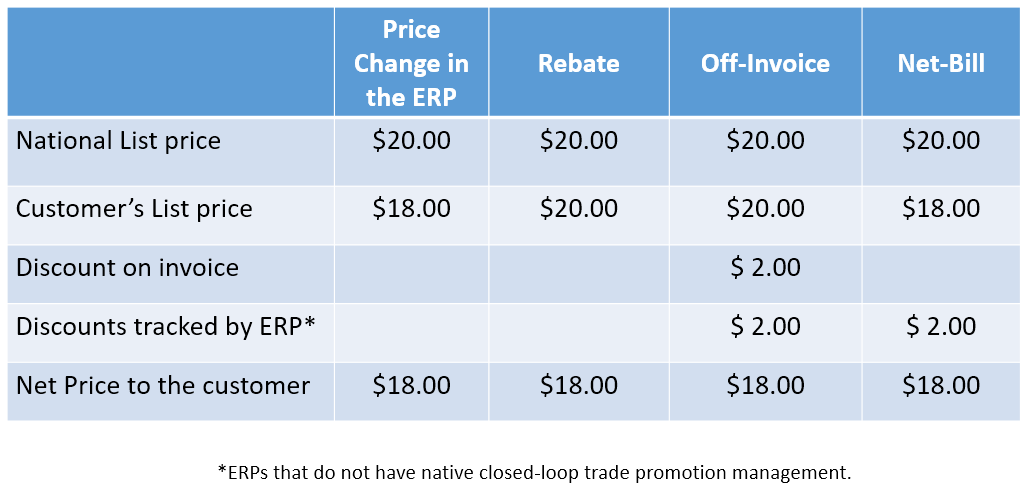
You need to give your largest customer a discount for several months or longer. What's the difference between changing the customer's list price in the ERP, giving a rebate, an off-invoice allowance or giving it as a net-bill?
As it turns out, it does matter how you discount your products. Let's explore these options from the perspective of the manufacturer:
Change the customer's list price? It is common to just change the list price of a product in your ERP to create a customer-specific price list, While this is a quick and easy way to reduce the price for a large customer, it has many draw-backs. Changing a list price 'hides' this change in standard P&L reports. While rebates, off-invoice and net-bill allowances appear as expenses on a customer P&L, a change in list price only reduces the top-line revenue. That revenue reduction isn't broken out on most reports. The price change is only apparent when comping the average list price across customers for the same items, and sometimes cash-discount, price-brackets and other non-promotional pricing differences can mask the impact of a customer-specific list price. As it is often said, anything that isn't analyzed can't be managed. Changes in list price often don't have budgets, and once implemented the customer-specific pricing action may remain in place longer than intended. Ok, so if a change in list price for the customer isn't a good option, what are the other options?
Reduce the price with a Rebate? Manufacturers may consider rebates a financially conservative way to discount their products. The concept is simple. Hold back the discount incentive until you can verify the retailer qualifies for the discount. However, rebates offer several challenges. Manufacturers need a TPM solution to keep track of bill-backs by promotion by item by customer. Without a TPM solution, rebates are time-consuming to track, monitor and analyze. For example, the bill-back monies owed may be taken by the retailer in the form of a deduction that is long after the promotional event, and short-paid on an invoice that's totally un-related to the promotion's products. The TPM solution must match the rebate expense back to the correct items and time periods for accurate historical P&Ls. Another challenge is tracking the outstanding liability. With a list price change, OI or net bill, there is no outstanding liability. With a rebate, you have offered a discount that will be settleled sometime in the future. Without a good TPM solution, rebates create more administrative work and can make it difficult to know what bill-back rebates are still outstanding. If you don't have a TPM solution, what about off-invoice?
Off-invoice allowances? Off-invoice allowances are much 'clearer' from a financial perspective. The discount is shown on the invoice, and there are no trade promotion surprises because the trade spending is expended at the same time it is incurred. While this sounds great, you already guessed correctly that there are challenges to OI. For example, retailers often establish the everyday retail price on the shelf using the manufacturer's 'list' price. A bill-back rebate is paid after the transaction, so many retailers do not factor off-invoice allowances when they calculate their everyday retail price. The result is an every-day price that's higher than what you expect, and higher than your trade spend should be achieving. Don't despair. If you don't have a TPM solution, net-bill may be the answer for long-term customer specific pricing.
Promotional allowances as net-bills? Net-bill is essentially an off-invoice allowance that's invisible to the customer. Just as if you changed the list price in your ERP, a net-bill allowance will not appear on the customer's invoice. Your ERP will show a 'net' price on the invoice, which is the result of subtracting the net-bill allowance from your official list price. This provides the clean accounting of an off-invoice allowance with the 'no discount' perception of the customer. Unlike the list price change, a net-bill allowance can tracked and can be a trade promotion expense or a revenue adjustment on the P&L. From a customer perspective, the customer specific price and the net-bill approach are the same. The retailer doesn't see any discounts on the invoice... just the dead-net price.
I suggest CPG manufacturers and distributors do not simply change the customer's list price when a long-term pricing action or EDLP strategy is required. Net-bill is a good option to track the costs of the pricing action in your ERP. Rebates, OI and Net-bill allowances are much better ways to execute your short-term promotional events if you have a trade promotion management solution. A TPM solution will provide the tools to manage these rebates and allowances to help achieve your brand's financial and sales goals.
Alex Ring
President, CG Squared
